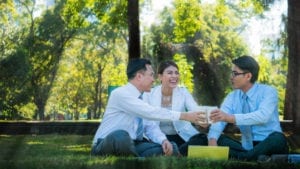How we answer this simple question shapes the way we see the world.
If we see ourselves as being apart from nature, we see nature as an “other.” We don’t need to consider nature as something we are connected to or something we need to fully understand. We don’t have a reciprocal relationship. We can set ourselves above nature and use nature for our own ends without worrying about the effect we have on it.
When we see ourselves as a part of nature, we are fundamentally connected to nature. We don’t see ourselves as separate, rather as another species in a larger ecosystem of the natural world. Nature isn’t an “other” rather it is part of us and we are part of nature. This shifts our relationship to nature. We understand that nature and people are part of one system. Therefore, when we hurt nature, we hurt ourselves as well.
This simple question shapes our worldview. A worldview expresses a set of background assumptions that often is subconscious. When we make our worldview conscious, we begin to see how unexamined beliefs and assumptions shape our behaviors, thinking, and relationships.

Applying our Worldview to Influencing Change
If we extend our “being a part of nature” thinking into our strategies to influence change in our organizations or communities, we start to shift the way we think about changing the system around us. F. David Peat wrote a book titled Gentle Action: Bringing Creative Change to a Turbulent World. What is so great about this book is the worldview that influences how he thinks about change. Instead of starting with the assumption that we are separate from the system we are trying to influence, Gentle Action assumes that we are a part of the system we are trying to influence.
This simple and profound shift creates a powerful and new way to think about influencing change and leading a living organization. Gentle Action starts with the assumption that we have an interdependent relationship with the organization or system we are trying to influence. Therefore, when we shift our behavior, we also shift the dynamics of the system we want to change.
Our behavior flows down our network of relationships which in turn influences how others are behaving in the system. The chart below shares a few examples of how our approach to change would shift if we saw ourselves as part of our living organization’s system:
How Our Worldview Shapes our Approach to Leadership and Change
When we see ourselves apart from nature – The traditional approach to influencing change |
When we see ourselves as a part of nature – Gentle action approach to influencing change |
| I regard what I want to change as “other” | I recognize that I am part of the system and part of what needs to be changed |
| I look for the one leverage point in our organization and use it to change the organization. I ask, “Who can make this change?” | I look for an array of approaches that mutually reinforce each other. I reflect on what interactions will help facilitate change in our system |
| I use power, structures, and processes to make change. It is my responsibility to come up with the solutions that the organization needs | I realize sustainable change flows along lines of relationships and ideas and that people support solutions that they help to create |
| I only attempt to change things I have the power to control | I can effect change every system within and around me because I am connected to the system I want to influence |
These different statements about influencing change start from two different worldviews. And those worldviews start with how we see ourselves in relationship to nature. In one worldview, we need power and resources to effect change. We have power over the system and seek to control the change we want to see. In the other worldview, we understand we are a part of the system and we need relationships, ideas, and energy to effect change.
Change will flow along the lines of relationships instead of positional power. When we use relationships and ideas to facilitate change we create change that is sustainable and doesn’t require power and resources to hold it in place.
Dr. Kathleen E. Allen writes a blog on leadership and organizations that describes a new paradigm of leadership that is based on lessons from nature and living systems. She is the author of Leading from the Roots: Nature Inspired Leadership Lessons for Today’s World (2018) and President of Allen and Associates, a consulting firm that specializes in leadership, innovation, and organizational change. You can sign up for her blog on her website: www.kathleenallen.net







Can we believe that the human race could become extinct ?
If you believe,you will not believe